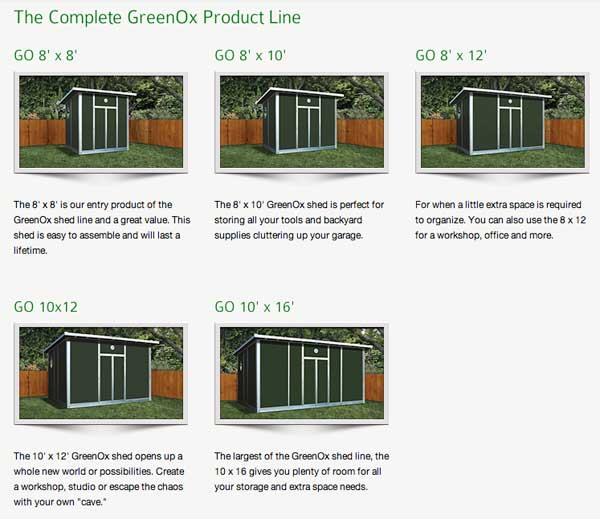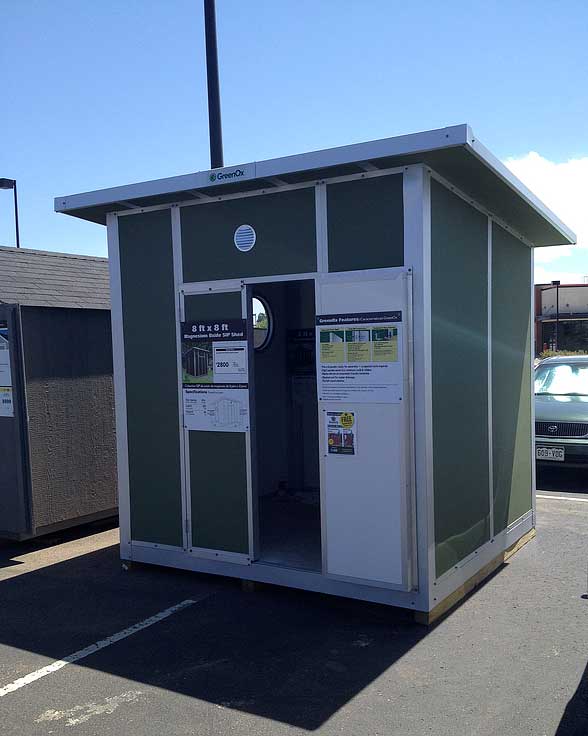by Jim
I was driving past my Lowes in Littleton Colorado and saw the attached GreenOx shed.
Do you know much about them? Seems pretty new but they are introducing a 12 x 16 model soon.
The price for that 8×8 model is $2,800. A bit pricy maybe but a trade off with ease of assembly and insulation factor. I am sure the fire proof shell adds to that cost. With all of our dead pine trees and already dry summer, the fire proofing is getting a lot of talk here in the dry West.
I went inside the model and seems very solid. Not a lot of Information on the Internet yet. One YouTube video on the assembly.
Would love to know if others are seeing them and trying them.
Here is some basic information from their website and Jim’s photo.
Panelized Design
GreenOx utilizes Structural Insulated Panel SIP technology, which is used in the home building industry to produce the strongest,safest and most energy efficient homes on the market.
The panelized design also makes the GreenOx easier to assemble.
Advanced Materials
Magnesium Oxide (MgO) provides the panels with extra strength, fire resistant surface and resistance to insects, mold and mildew.
Versatile
GreenOx is ideal for traditional storage or, because it is highly insulated, can be used for a comfortable workshop, office, “man cave,” pool house, studio, playhouse and more. The possibilities are limitless.
Strong & Durable
Thermally resistant Structural Insulated Panel (SIP) construction using only the highest quality steel and aluminum to provide exceptional strength & durability.
Clean Retro-Modern style
GreenOx’s clean lines and pitched roof harken back to how sheds used to be built.
Environmentally Friendly
GreenOx contains no organic solvents, silica, heavy metals or other toxic elements.


I’ve had this thought more than once. I haven’t seen the Green Ox brand since I’m in Texas. It would make a great sleeping and stuff shelter if you were doing most of your living outside. I would want to cook and perform most other functions outside to keep it as cool as possible when it was time to bed down for the night.
These recently came to the Lowes here in North Carolina and I took a gander inside. They seem to be well-built for the long-haul.
Great find, Kent! Thanks for the post!
I don’t know a whole lot about SIP construction. Does anyone know how you would run electrical wiring with the panels? Or how difficult it would be to make alterations, like cutting holes for additional windows?
Interesting how shed designs might be a good “pre-fab” basis for tiny house building.
A Pal who has built his own House[s], as have I, used ‘conventional’ SIP Panels. By ‘conventional’, I mean the SIP Panel type where it’s 2 sheets of OSB glued/bonded to a core of Styrofoam of varying thickness. These ‘Ice Cream Sandwich’ Panels are very strong.
Windows were cut on-site with a Sawzall after marking off the desired side of Window openings. There’s no advantage to pre-cutting such openings, and the on-site approach reduces errors. Wiring cutouts are also done on site. Or, some ‘chases’ can be pre cut, by using an ordinary Router. Routers are the usual method/Tool used. Romex wiring is then placed in routed chases. Interior Drywall goes over these routed chases, and all the Interior OSB, to meet Fire Prevention Specs.
It’s somewhat easier to have a Floor on Joists. Then, wiring can be brought up from below.
Regarding Fire-proofing, folks need to understand that, as Fire gets close, it’s a well known phenomenon for Windows to not be able to take the incredible heat. They blow out and break. Then, intense Infrared Radiation directly heats internal Shed/House items and ignites them. So, unless one wants to live in a windowless ‘Bunker’, the Green Ox construction Method/Materials advantage is academic [irrelevant].
The old Novel ‘Farenheit 451’ refers to the temperature at which Paper and flammables ignite.
We have a Mountain House not that far from the ‘High Park’ Fire burning up N. CO.. You learn details of Fire behavior from the Locals.
Thank you for this information. It is very helpful.
Given what these panels are made of, it’s a safe to assume they outgas like crazy. I worry about people building with them, or anything else that outgasses, and then spending time in the small enclosed space breathing the fumes. If someone has more info on this, please share.
Actually Elizabeth the panels are pretty much inert in their final form. The substrate (skin) is fully reacted so has nothing else to contribute to the atmosphere. The foam core off gasses 85%+ of the pentane within 48 hours of production where it is captured. Any remaining residual gassing is gone by the time it reaches final production.
Well to help Elizabeth, on the website for greenox, according to the website GreenOx contains no organic solvents, silica, heavy metals or other toxic elements.
So not sure about any outgas.
I went to watch the youtube video with the construction it is so simple I would feel comfortable myself to put it together.
It is too bad no options for windows or doors, that would be nice if opening windows and a full glass door option were available.
Looks to me you can join two units together (example:two 10×12 to make a 10×24) to make it larger.
The price is rather reasonable.
The parent company is Vantem Composite Technologies which make other nice products too.
I doubt shed makers would spend extra money in order to source formaldehyde-free panels.
I stand corrected. Their site says their panels “Contain no organic solvents, heavy metals or other toxic ingredients”
Nice to know. Thanks for the info.
Here in North Dakota, with an incredible housing shortage, a number of builders are building 12’x24′ puds and either joining them together to make apartment houses or on trailers for highly energy efficient “mobile” homes. The ones I’ve seen are cut on site and have used soffits to run their wiring, etc. See below for a tutorial on MGO-sips.
http://thepanelman.com/tag/mgo-sips/
http://valubuild.net/manufacturedmodularhome.asp
Here’s another site that as you make your way down there is a book on building with SIPS. This is the future for economic heating and cooling.
I doubt that SIPs are the future of economic heating and cooling. The sun and the earth will remain the only true source of economic heating and cooling since they eliminate or greatly reduce the need for supplmental systems.
SIPs themselves are unproven and more importantly unsustainable (lots of energy required in the production of OSB, expanded polystyrene is an hydrocarbon based product).
I would not want to live in a cesspool of chemical materials with no real infrastructure in the building.
Keep in mind that SIPs only benefit one group of people – the profits of builders. A manufactured house will always have the charm of a cardboard box.
The SIP stuff sounds great, but nobody ever gives real-world numbers about them or about insulation in general.
Sites, including the SIP manufacturers site, all list “R values” but they never say what that translates to in temperatures. The temperature is *not* the same everywhere, so it would be nice to know what R value is right for each temperature – especially if you live somewhere with winters of +10C or -40C.
A useful map showing recommended R values for various US locations can be found at http://www.goodlifeenergysavers.com/r-value/ Otherwise just go with local building codes.
Long before the tiny house idea became something anyone thought was sane at all, I used to love to go to the Home Depot parking lot and go inside all the sheds and invision where the kitchen, dining room, bedroom, and bathroom would fit. I like the shed idea. It is nostalgic for me.
I visited my local Lowes in Chesapeake, VA and they had one of these. It looks quite nice. But I would like to know if I can substitute the panels on the
south side for full size windows (or panel size).
Apparently Green Ox is no longer in business.. Over engineered the shed design and had a hard time selling a $2,700 8×8 shed at Lowes. Does anyone have one one these sheds? I just bough two of the model buildings at Lowes here in Texas at a fraction of the original msrp. I have some questions about how the doors latch because they weren’t installed on the store model/ demo. Anyone have any additional details other than the installation manual as it doesn’t say much about the latching mechanism of the doors. Thanks!